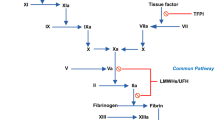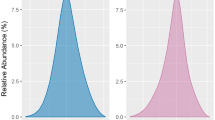Summary
Studies on the pharmacological and pharmacodynamic properties of heparins are complicated by the heterogeneity of heparin preparations. It is important to consider the molecular weight distribution, which may differ from one preparation to another. Molecules with a molecular weight ranging from about 2000 to 5000D are abundant in low molecular weight heparins (LMWHs), while they are present at a very low concentration in standard heparin. The clinical relevance of this difference is not fully understood.
Recent work from our laboratory demonstrates that factor VII activation to factor VIIa in vitro is significantly inhibited by heparins. This is another aspect of some importance in understanding the mechanism of action of heparins.
The bioavailability and plasma clearance of anti-Xa activity are well documented. In contrast, clear results regarding the bioavailability of anti-IIa activity are still missing.
Recent data indicate that the anti-Xa activity of different molecules of heparin does not increase in parallel with the molecular weight of the heparin chain. In contrast, the anti-IIa activity of different molecules of heparin increases in parallel with the molecular weight. This could explain why activated partial-thrombo-plastin time is less prolonged with LMWHs than with standard heparin.
There is growing evidence that anti-Xa activity contributes to the antithrombotic effect of heparins, although it is generally accepted that anti-IIa activity plays a major role.
There have been 3 important findings from recent work on the pharmacology of heparins: i) heparin at a very low dose has thrombopoietic activity; ii) in hip surgery, the incidence of heparin-induced thrombocytopenia is significantly lower in patients receiving subcutaneous LMWHs for 2 weeks compared with patients receiving unfractionated heparin; and iii) the risk of osteoporosis with long term treatment with LMWHs seems lower than with standard heparin.
Similar content being viewed by others
References
Fareed J, Walenga JM, Hoppensteadt D, et al. Biochemical and pharmacologic inequivalence of low molecular weight hepa-rins. Ann N Y Acad Sci 1989; 556: 333–53
Linhardt RJ, Loganathan D, Al-Hakim A. Oligosaccharide mapping of low molecular weight heparins: structure and activity difference. J Med Chem 1990; 33: 1639–45
Bendetowicz AV, Pacaud E, Beguin S, et al. On the relationship between molecular mass and anticoagulant activity in a low molecular weight heparin (enoxaparin). Thromb Haemost 1992; 67(5): 556–62
Hemker HC. Discussion. Avoiding thromboembolism and its sequelae: the role of reviparine sodium, LMWHs are not equal. Kakkar VV, Samama MM, editors. Thromb Res 1996; 81 Suppl. 2: S36–8
Bara L, Bloch MF, Zitoun D, et al. Comparative effects of enoxaparin and unfractionated heparin in healthy volunteers on prothrombin consumption in whole blood during coagulation, and release of tissue factor pathway inhibitor. Thromb Res 1993; 69: 443–52
Gerotziafas GT, Bara L, Bloch MF, et al. Treatment with LMWHs inhibits factor VIIa generation during in vitro coagulation of whole blood. Thromb Res 1996; 81: 491–6
Iverson N, Abildgaard U. Role of antithrombin and tissue factor pathway inhibitor in the control of thrombosis and mediation of heparin action. Clin Appl Thrombosis/Hemostasis 1996; 2(1): 1–6
Eriksson BI, Söderberg K, Widlund L, et al. A comparative study of three low molecular weight heparins (LMWHs) and unfractionated heparin (UH) in healthy volunteers. Thromb Haemost 1995; 73(3): 398–401
Collignon F, Frydman A, Caplain H, et al. Comparison of the pharmacokinetic profiles of three low molecular mass heparins — dalteparin, enoxaparin and nadroparin — administered subcutaneously in healthy volunteers (doses for prevention of thromboembolism). Thromb Haemost 1995; 73(4): 630–40
Agnelli G, Iorio A, Renga C, et al. Prolonged antithrombin activity of low molecular weight heparins. Clinical implications for the treatment of thromboembolic diseases. Circulation 1995; 92: 2819–24
Dawes J. Interactions of heparins in the vascular environment. Haemostasis 1993; 23(1): 212–9
Young E, Wells P, Holoway S, et al. Ex vivo and in vitro evidence that low molecular weight heparin exhibits less binding to plasma proteins than unfractionated heparin. Thromb Haemost 1994; 71(3): 292–300
Lane DA, Denton J, Flynn AM, et al. Anticoagulant activities of heparin oligosaccharides and their neutralization by platelet factor 4. Biochem J 1984; 218: 725–32
Carrie D, Caranobe C, Boneu B. A comparison of the antithrombotic effects of heparin and of low molecular weight heparins with increasing antifactor Xa/antifactor Ha ratio in the rabbit. Br J Haematol 1993; 83: 622–6
Millet J, Theveniaux J, Tachon G, et al. The antithrombotic potential of dalteparin in man assessed indirectly by Wessler’s technique. In press, 1996
Shen ZX, Li JM, Wang ZY, et al. Thrombocytopoietic effect of heparin given in chronic immune thrombocytopenic purpura. Lancet 1995; 346: 220–1
Amiral J, Wolf M, Fischer AM, et al. Pathogenicity of IgA and/or IgM antibodies to heparin-PF4 complexes in patients with heparin-induced thrombocytopenia. Br J Haematol 1996; 92: 954–9
Warkentin TE, Levine MN, Hirsh J, et al. Heparin-induced thrombocytopenia in patients treated with low molecular weight heparin or unfractionated heparin. N Engl J Med 1995; 332: 1330–5
Carter CJ, Kelton JF, Hirsh J, et al. Relationship between the haemorrhage and antithrombotic properties of low molecular weight heparins in rabbits. Blood 1982; 59: 1239–45
Matthiasson SE, Lindblad B, Stjernquist U, et al. The haemorrhagic effect of low molecular weight heparins, dermatan sulphate and hirudin. Haemostasis 1995; 25: 203–11
Leizorovicz A, Haugh MC, Chapuis FR, et al. Low molecular weight heparin in prevention of perioperative thrombosis. BMJ 1992; 305: 913–20
Monreal M, Lafoz E, Urrutia A, et al. Effects of long-term therapy with either heparin or low molecular weight heparin on serum lipid levels. A prospective study. Haemostasis 1995; 25: 283–7
Shaughnessy SG, Young E, Deschamps P. et al. The effects of low molecular weight and standard heparins on calcium loss from fetal rat calvaria. Blood 1995; 86: 1368–73
Monreal M, Lafoz E, Olive A, et al. Comparison of subcutaneous unfractionated heparin with a low molecular weight heparin (Fragmin) in patients with venous thromboembolism and contraindications to coumarin. Thromb Haemost 1994; 71: 7
Author information
Authors and Affiliations
Rights and permissions
About this article
Cite this article
Samama, M.M., Bara, L. & Gouin-Thibault, I. New Data on the Pharmacology of Heparin and Low Molecular Weight Heparins. Drugs 52 (Suppl 7), 8–15 (1996). https://doi.org/10.2165/00003495-199600527-00004
Published:
Issue Date:
DOI: https://doi.org/10.2165/00003495-199600527-00004




